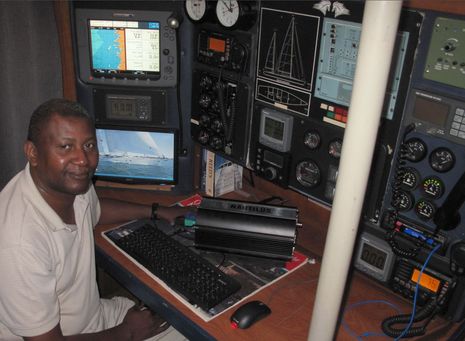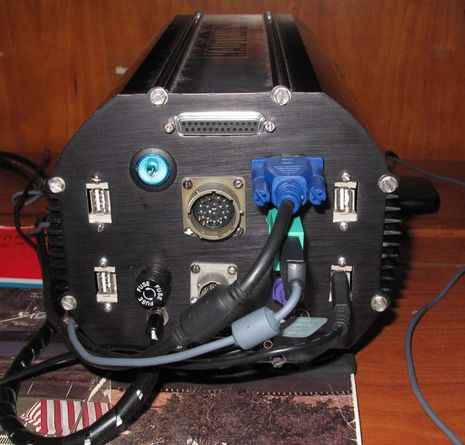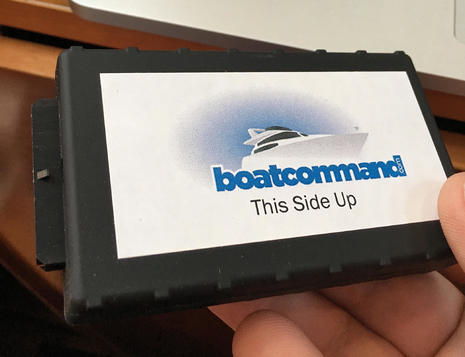RAPC Nautilus, toughest marine PC yet?
This is my favorite sort of show and tell. The guy doing the showing, Bob Hilliard, is the chief engineer involved, and the location was the nav station of the 105-foot ketch Apache, which will be a beta site for Bob’s creation, the RAPC Nautilus marine PC on the chart table. I admit to being a bit dazzled by the boat, which you can gander in this old charter listing, and the Pinot Noir, but I’m thinking that’s the most bullet-proof boat computer I’ve ever seen…
For one thing, that fanless, and purportedly waterproof, box contains its own UPS (uninterrupted power supply). Bob demonstrated by pulling the DC power supply; the demo monitoring and charting software running on the screen behind him kept on going for a minute or two, and then, along with Windows, shut itself down gracefully. Perhaps more remarkable are the dual processors at work in the Nautilus. Not just “dual core” — though each processor could be, which would then yield “dual dual” — but two parallel motherboards, which means that a whole internal computer could fail and your software would keep on keeping on. Nice, and maybe only possible because Nautilus doesn’t have the sort of motherboards we’re used to. Hilliard has both personal and business history with military technology, and RAPC designs are based on an “extreme environment” PC/104 hardware standard I had not heard of before. It’s small, modular, and very low power.
Now Nautilus is a “call for quote” level of computer, not inexpensive, but may be just the thing for big, PC-centric vessels. I’m hoping, in fact, that the young crew of Apache, soon to become an adventure charter operation, will let us know how the boat’s systems work once they’re rebuilt around Nautilus. I’ve also heard that a certain large marine electronics company is looking at an RAPC machine with NMEA 2000 built right in, and I might see it under their brand at the NMEA Conference next week. Cool.














XP? are you kidding? is it made by B&G? XP is and ESL OS….
There’s nothing new or unusual here. Pc/1o4 has been around for years, especially in Europe. It’s been widely used in industrial computing. It’s not particularly expensive.
Dave
Right, Dave. According to that Wiki link, PC/104 has been around since the early 90s. But is there anyone else using it to make PCs suitable to boats, i.e. meant to run on DC, minimal power draw, lots of serial I/O? Please give us links to such manufacturers.
John, what does “ESL” mean? The Nautilus specs linked to are just a sample of what’s possible, I think. Some boat integrators still prefer XP, but you can get what you want on the RAPC machines.
Ben,
Its quite easy to use PC/104 to build “marine Pc”, The box used is a standard PC 104 “Cantainer” and there are several DC power supplies available ( try google). I would prefer mini-itx.
See
http://www.tme-inc.com/products/EP301V.asp
http://www.acrosser.com/solutions/In-Vehicle-PC-Bus-PC_index_classid_4.html
http://www.winsystems.com/
theres many more. Im not running down the “Naitilius” but any competent industrial PC engineer can put these off the shelf parts together
Dave
Ogh I forgot the UPS PC104 system is standard, available from TRi-M
http://www.dpie.com/pc104/pc104_powersupply.html
as are the “Cantainers”
http://www.dpie.com/pc104/pc104_chassis.html
The fact is the Nautilius and Nemo ( the smaller version) is a standard PC104 using off the shelf parts. and it runs Windows XP. BTW their website offers no explanation as to how the dual processor boards are used, since XP as no real supprt for this.
The other thing is that how does the dual PC board work, Windows cant handle this, hence in my opinion its not a hot swap system, but a cold swap one, ie the system is swictched to the backup board and re-booted. Hot swap is a very trickey architecture at a software level, as its requires dual running applications that lock step together
Dave
Ben, ESL means end of service life. In other words Microsoft will soon no longer provide support for XP.
Funny thing though is most places I go still seem to be running XP.
Looks like a very heavy duty computer for sure.
It’s interesting to see someone selling dedicated marine gear based on PC/104 derived standards (I would hope they’re using the more modern PCI/104 or PCI/104-Express forms, not the original ISA-based version). Given enough money, you can build a pretty powerful, compact, ruggedized system on 104-express. Some of the folks at boatdesign.net have been musing for a few years about building systems like this, but I’m not sure if anyone’s got around to it yet.
As long as it’s not going to be networked, XP is fine. If it’ll be used as a serious PC, I’d hope it can run a more modern OS (Ubuntu 10.x, Win7, etc.) that will be supported for the foreseeable future.
I’d be quite curious to find out what the dual-mainboard system actually is. It’s hard to tell whether it’s a cold swap on restart setup (probably doable with a custom BIOS), or a hot swap on failure (really tricky), or a setup where both are used normally, and one takes the whole load if the other fails (also really tricky).
The way I understood it from Bob was that a failure one processor module would be transparent to the user (assuming the two were in redundancy mode), which sounds like a hot swap. But then again I was sitting on a super yacht moored off Newport after a very long day 😉 I’ve asked Bob to address the questions here one way or another, but he may be off somewhere today.
Allow me to clear up a few misconceptions and shed additional light on our products.
104 has been around for years. The technology tends to be found in the military and medical world due to significantly reduced power draw (usually 75-90% less), reduced heat dissipation, extreme resistance to vibration and corrosion and direct DC input. 104 is far more reliable than typical computer components. In these markets, durability and reliability usually trump price.
We don’t claim our products to be new and ground-breaking technological achievements. We have, however, adapted 104 technology to the marine environment. We’re unaware of other units built like ours to satisfy the demanding needs of the marine market. In addition to the unique benefits offered by 104, you will find NO MOVING PARTS in our standard products. Thus, our units are far less likely to fail.
Could anyone buy the parts and build a 104 system? Yes. Anyone could also buy parts and build a standard mini-tower. Despite that, Dell, HP and others still sell millions of units every year.
The Nautilus (dual processor unit) has been misconstrued by the readers. Think of it as two independent computers in one box. You can use two monitors, two keyboards and two mice or a KVM switch. The independent systems can simultaneously run the same or different applications. For example, one system can monitor your vessel’s engines and tanks while the other handles radar and navigation chores. A properly configured Nemo can do that also, but you have a choice. There is no “fallback” or automatic switchover in the event of a system failure. It’s a manual operation.
The Nemo and Nautilus run Windows XP or Windows 7 in 32- or 64-bit mode. Microsoft announced support for XP until 2014. If an application runs on Windows, it will run on our systems.
104 product is very expensive relative to standard computer components. That’s a simple fact of life. We’re well aware that one can purchase a laptop for under $500, plug in a GPS antenna and radar module, run Nobeltec and monitor weather. We’re also aware the typical laptop in a marine environment has a short lifespan. Not everyone needs to run Maretron and monitor numerous systems found on some vessels. Thus, one gets to make a choice between durability, function and cost. Also remember that the initial price is only part of the cost of ownership.
The ESL moniker means nothing. We thought it sounded good. 104 specs change as rapidly as those of conventional computers. Our website is still a huge work in progress. We’re changing, modifying then changing again.
Lastly, 104 gives us the ability to configure almost anything you can imagine. We can custom build for YOUR needs. Thanks for your interest.
John Carullo
Director of Operations
RAPC Technology Partners
PC104 is just a standard for form factor and bus, not a standard for the components being more robust than others. The PCB’s are the same, components are the same, etc. as a regular computer, except a bit back in time. There’s no power draw advantage to PC104 over a regular but “light” computer system. I had a bunch of Aaeon SBC’s and they crapped out far before my PC hardware, and on my PC hardware I could easily replace the motherboard/etc which did fail. The only thing you should NOT use on your boat are desktop hard disks – you need a 2.5″ designed for laptop/mobile use unless you have a very large yacht 🙂 (Does not include 2.5″ enterprise drives)
It’s also likely a poor choice for this application. Mini-ITX boards are everywhere, inexpensive, just as reliable, and with the Atom they can be good performers while being quite power conscious. They’re far ahead of the times compared to PC104 as they’re in far higher quantities. Hell, there’s even PS/2 ports on that board! 🙂
Failover could be easily automated with a couple bucks of external hardware connected to the USB ports of each board, a video switch and a usb switch. This setup could easily listen to the same 0183 GPS output, or one per each for redundancy, leaving you ready to switch over to the next for navigation at a moments notice. Keeping the two nav screens in sync would require some custom software.
Missing are the important components to tie these things all together – an embedded system to interface with the NMEA2000 bus (or buses), handle power management/hot swap between the two, and control any number of external devices. Integration is key.
Right now, you have two simpleton computers in a big case, with rudimentary “power backup” and a big markup – nothing above what people with laptops in their boat already have, for far less money.
Patrick –
You are certainly entitled to your own opinion, but not your own facts.
Yes, PC104 is a form factor and bus standard. However, you are incorrect if you assume it means nothing else as applied to our products.
We have experience with DOD and law enforcement. Our products ARE “more robust than others” and do draw significantly less power.
As to a NMEA interface . . . . Stay tuned.
John Carullo
Director of Operations
RAPC Technology Partners
John,
Sorry to barge in, but… I read Patrick’s email and thought he was sound and unbiased about his opinion. I missed where he misrepresented the facts on his opinion about the PC104?
I strongly believe that implying that you might have experience with DOD and LAW enforcement is a bit misleading, unless you state if the product or solution that you have experience with was certified under a specific standard that would otherwise not be met by any off the shelf solution.
For example, I have sold Laptops to both the DOD and LAW enforcement agencies in the past, but it was something that was irrelevant to the laptop that was selected and how their build met any rigorous standard that could classify the specific product.
On the other hand, I can say that now I am building a product that will meet the MIL-Spec and many of the other military standards out there, about 20 of them, and let me they you, the company I work for has spent millions on getting the specs certified…. for more on specs look here:http://en.wikipedia.org/wiki/United_States_Military_Standard
As for robustness, there are many ways to skin a cat, and if you don’t like others POV, then express that or back up the facts, I found them quite lacking.
I am sure anyone can come up with a hack to have all the SW running on a VM, and a simple system monitoring it, if it fails, have the system boot from a second copy of the VM on a separate HW and all should be back up and running, see, the HW was irrelevant in my example.
All the best and BTW I like your PC Canister.
Jemo
I visited the RAPC web site. The Cantiner system shown has a fingerguard on one end, which I assume means it has a fan. Even if all the boards are
conformally coated, circulating moist, salt air through the enclosure is not a
recommended practice. Completely fanless operation is the real goal, although conduction cooling to external heatsinks which may have a sacrificial fan is an acceptable alternative.
While the VIA and Atom processors remain quite attractive because of the richness of the x86 ecosystem, looking forward to new designs, the cost and power advantage and performance parity of the new ARM processors will only make it more difficult for competitive designs to remain slavishly attached to the x86 for the benefit of running Windoze.
An even bigger, but admittedly more speculative, threat is that the iPad stands a good chance of becoming a defacto standard for implementation platform a graphical User Interface. It has both WiFi and Bluetooth, has a great screen and remarkable performance, and as a result, is transforming UI design at a blistering pace. Why go to the effort and cost of reproducing that when the systems could just be “black boxes” with the UI delivered on what would be a replaceable (if not “disposable”) UI surface? That gives the systems designers more freedom building the software in those black boxes because there is no need to run a Windoze API.
‘Twill be interesting to watch evolve.
Having just built a Z530 atom based PC/104+ system running Debian, it seems to be that the ease of integrating digital and analog IO cards is the big advantage of PC/104. We’ve got 10 serial ports, 24 digital ports (input or output) and a bunch of analog inputs. I’m sure there are CAN cards available for NMEA2000 integration. We looked at PCI104 but the IO cards we needed were either not available or much more expensive. We also didn’t need the added speed. Low power usage was our primary goal.
The processors available on PC/104 aren’t usually cutting edge. For my own boat, I’d go this route for a dedicated autopilot/Physical IO computer but not for navigation/communications/browsing/general use. It’s not cost effective IMO.
Also, If you are going to all this trouble to make a rugged PC, I’d spec an IP68 housing and connectors. This will require that you use non-standard connectors (we used Souriau’s Hi-seal and some Bulgin Buccaneer) but true peace of mind is being able to wash down your computer with a hose.
Some other good PC/104 sources are:
Diamond Systems and Advanced Digital Logic.
And I’m sure WinXP will be with us for a very very long time. Just look at IE6!
It ain’t boatproof until you can play water polo with it while it’s running. In msny cases, milspec falls short of fulfilling a need by over-spec’ing with out of date terminology.